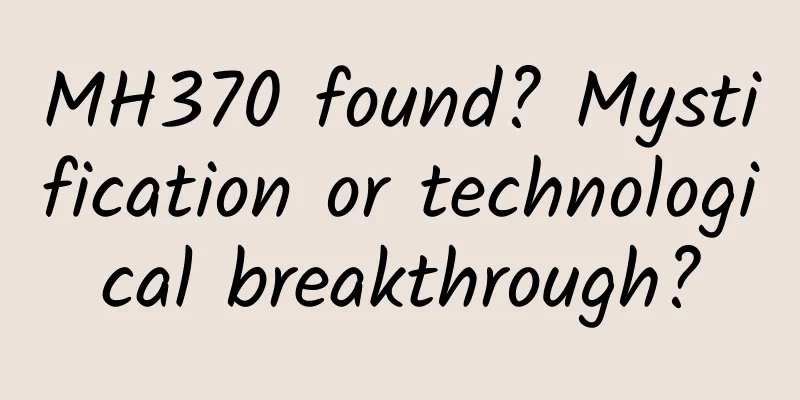MH370 found? Mystification or technological breakthrough?

|
More than seven years later, news about Malaysia Airlines flight MH370 has once again become a hot topic. British aviation engineer Richard Godfrey said in a report released on November 30 that he had discovered Malaysia Airlines flight MH370 using a revolutionary tracking technology. He said the plane crashed in the Indian Ocean 1,993 kilometers west of Perth and is currently 4,000 meters below sea level. ▲British aviation engineer Richard Godfrey claimed in a report released on November 30 that the main location of the crash of Malaysia Airlines MH370 was at the foot of Broken Ridge. (Screenshot of Richard Godfrey's report.) Richard Godfrey, a founding member of the expert panel MH370 Independent Group, said he was "very confident" that new mapping software had pinpointed the crash site of the Boeing plane, The Times reported. According to Australian media reports, based on the aviation tracking technology used by Richard Godfrey, MH370 crashed into the ocean at 33.177 degrees south latitude and 95.300 degrees east longitude, 1,933 kilometers west of Perth, Australia, and fell into the seabed 4,000 meters deep. "The main crash site is at the foot of Broken Ridge, where the underwater topography is very complex," Richard Godfrey said in the latest report. "There are a number of exposed mountains and cliffs, an underwater volcano and a canyon." Richard Godfrey predicts that if the relevant area is searched carefully, flight MH370 will be found in the second half of 2022. The report said the predicted location of MH370 matched an ocean-drifting analysis of 33 pieces of debris that may have come from the missing plane and have been found over the years in Mauritius, Madagascar, Tanzania and South Africa. Richard Godfrey, a plane crash survivor, has been searching for the whereabouts of Malaysia Airlines. This news also rekindled everyone's hope of finding the flight. In response, experts from the Flight Global Tracking and Surveillance Technology Research Center of Civil Aviation University of China said that the method used by the British aviation engineer to find MH370 is theoretically credible, but it requires a lot of data support and analysis. Whether the location of MH370 can be accurately found requires the engineer to further disclose the data and detailed process of the analysis. What technology did British aviation engineers use to find MH370? Experts from the center team introduced that British aviation engineer Godfrey used data information collected by the globally established "Weak Signal Propagation Reporter" (WSPR) and software to infer the location of the MH370 aircraft. WSPR is software that allows radio amateurs to join a global network of low-power beacons. It was developed by Nobel Prize-winning Princeton University physicist Joe Taylor. The software allows you to use your own radio station to transmit beacon signals, and also receive beacons from other stations with similar equipment in the same amateur frequency band. Each participating station receives the beacon and uploads it to the web server. After the signal is transmitted, the receiving location and reception strength can be checked on the map, and the map can even show the propagation path of the signal. "The globally established 'Weak Signal Propagation Report' (WSPR) mechanism is equivalent to covering the earth with criss-crossing beacon lines. When an aircraft crosses certain beacon lines, it will cause weak interference to the beacon signal." Experts from the center team said that if we can obtain beacon signals around the world, connect all the interference information (accurate transmission and reception time, location) according to time points, and then exclude interference not caused by MH370, the remaining interference information should be caused by MH370. During the time when MH370 lost contact, there were almost no other aircraft in this direction of the South Indian Ocean. Therefore, within this range, by finding the connected beacon signal and the receiving and sending location of the weak signal transmission, we can preliminarily determine the location where MH370 passed. Godfrey claimed to have found seven receiving and transmitting points that were interfered with by MH370. If these seven receiving and transmitting nodes are connected and combined with the approximate range initially determined by the maritime satellite, drift analysis and Boeing's performance data, the final disappearance point of MH370 can be predicted more accurately. What are the commonly used aviation tracking and analysis technologies? In order to track MH370, technologies such as air traffic control radar, military radar, Doppler effect (derived from Inmarsat's satellite communication data), warning information (from ACARS messages sent by the aircraft), underwater beacons, buoy sonar, underwater monitoring network/hydrophone, towed sonar, and flight performance data simulation were used, but all ended in failure. Now, more than seven years have passed. What progress has been made in commonly used aviation tracking and analysis technologies? Can they help rescue workers quickly find the whereabouts of the plane if they encounter similar situations? Data map: Malaysia Airlines plane According to experts from the center’s team, currently commonly used aviation tracking and analysis technologies are mainly divided into three categories. The first category is the tracking service based on the ground data communication network, which is a flight tracking service provided by ground data communication service providers integrating various surveillance data. These tracking services integrate various location data sources operated by ground data communications service providers, including aircraft communications addressing and reporting system, contract automatic dependent surveillance, broadcast automatic dependent surveillance, radar surveillance data, high-frequency data link, etc. This type of tracking is based on existing technology and can fully utilize the data resources held by ground communication service providers to achieve location acquisition. It has low cost but is limited by the coverage of ground stations. The second category is the tracking service based on the satellite communication system, which is a flight tracking service provided by satellite communication service providers using their satellite communication capabilities. For example, the satellite-based ADS-B operated by Canada's Aireon makes full use of existing airborne equipment to achieve global coverage of receivers without blind spots. It was deployed in 2019 and can achieve 4D position acquisition with an update rate as low as 8 seconds. There are also plans to build a satellite-based ADS-B constellation in China. The short message communication function of my country's Beidou system can be used to obtain the aircraft's location and track it globally. It is currently China's only independently controllable tracking technology, but it requires a series of work such as airworthiness certification of airborne equipment. Under the leadership of the Civil Aviation Administration of China, the Civil Aviation University of China and Air China have jointly installed Beidou tracking equipment on 20 aircraft with relevant research institutes in April this year and put them into demonstration operation. The third category is the tracking service based on airborne flight data acquisition equipment. Airborne equipment manufacturers use the airborne equipment they develop to acquire flight status data, and then transmit it to the ground through rented satellite communication links to provide tracking services. Spacecraft need to install new onboard equipment, use the onboard equipment to obtain flight data, and use satellite communications to transmit data, which is a more flexible way to achieve global coverage. However, because it involves the modification of onboard equipment and airworthiness certification, the cost is relatively high. Review of the Malaysia Airlines MH370 incident In the early morning of March 8, 2014, MH370 carrying 239 people flew from Kuala Lumpur to Beijing. The 227 passengers on board came from 13 countries, including China, Malaysia, the United States, and France. The largest number of passengers were from China: 153 from the mainland and 1 from Taiwan. At 1:19 a.m., about 38 minutes into the flight, the plane made its last contact with the Malaysian tower. Co-pilot Hamid's words, "Good night, this is MH370," became the last words MH370 left to the world. Two minutes later, all communication equipment including the transponder on board was suddenly turned off manually, and the Boeing 777-200, which was more than 60 meters long, disappeared. Comprehensive sources: Science and Technology Daily, China Economic Net, China News Network, National Business Daily, Nandu Weekly, CCTV News, etc. |
<<: Do the flavors of liquor really exist?
>>: This lizard, named after the snake monster, has the ability to walk on water.
Recommend
10,000-word analysis: How the top 10 platforms use red envelopes to increase user growth during the 2020 Spring Festival
Every Spring Festival, the red envelope strategy ...
The battle for set-top boxes: a historic test for the State Administration of Radio, Film and Television
The Internet is impacting more and more tradition...
Why did Saudi Arabia build its capital in the desert?
Saudi Arabia, with an area of about 2.25 millio...
How to use growth hacking thinking for promotion?
Back to August 1, 2017, at 11:23 am, I was still ...
Lu Heping Channel Development and Dealer Management
Teach you to build a channel model that integrate...
What to do if you eat too much during the Spring Festival and have indigestion? Three easy ways to solve it!
Review expert: Peng Guoqiu, deputy chief physicia...
Small knowledge, big questions! Why do common fans only have 3 blades?
One leaf fan is invisible Two-blade fans are rare...
Boneless fried chicken can not only be eaten, but also used to control foxes | Natural Trumpet
Welcome to the Nature Trumpet column. In the past...
Weekly Achievements “Awards”丨“Confessions” of Scientific Climbers (Part 2)
Since the reform of the science and technology aw...
Online marketing solutions for the real estate industry!
The real estate industry is a typical highly cycl...
First of its kind in my country! This technology successfully crosses the "Death Valley" →
When it comes to PHA, you may feel unfamiliar. Bu...
I want to pee but can’t, it hurts when I pee, and I feel anxious if I don’t pee... Be careful of urinary tract infection!
Talking about urinary tract infection I believe e...
A guide to marketing using the college entrance examination opportunity, please save it!
The annual college entrance examination is coming...
Decoding the power of Snapchat from my social product syllogism
Snapchat is finally going public. The company has...
There is no such thing as "false hip width"! The widest part of a woman's hips is the thigh root.
Audit expert: Peng Guoqiu Deputy Chief Physician,...









